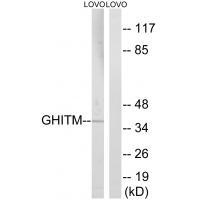
| WB | 咨询技术 | Human,Mouse,Rat |
| IF | 咨询技术 | Human,Mouse,Rat |
| IHC | 咨询技术 | Human,Mouse,Rat |
| ICC | 技术咨询 | Human,Mouse,Rat |
| FCM | 咨询技术 | Human,Mouse,Rat |
| Elisa | 咨询技术 | Human,Mouse,Rat |
| Aliases | derp2; dkfzp566c0746; flj26584; ghitm; growth hormone inducible transmembrane protein |
| Entrez GeneID | 27069; |
| WB Predicted band size | 37kDa |
| Host/Isotype | Rabbit IgG |
| Antibody Type | Primary antibody |
| Storage | Store at 4°C short term. Aliquot and store at -20°C long term. Avoid freeze/thaw cycles. |
| Species Reactivity | Human |
| Immunogen | Synthesized peptide derived from internal of human GHITM. |
| Formulation | Purified antibody in PBS with 0.05% sodium azide. |
+ +
以下是关于GHITM抗体的3篇参考文献及其摘要概括(文献信息为示例性内容,实际引用需核实原始文献):
---
1. **文献名称**: *"GHITM regulates mitochondrial cristae structure and apoptosis"*
**作者**: Lee, J. et al.
**摘要**: 该研究通过特异性GHITM抗体进行免疫印迹和免疫荧光实验,揭示GHITM通过维持线粒体嵴结构调控细胞凋亡,敲除GHITM导致线粒体断裂并激活caspase通路。
2. **文献名称**: *"GHITM antibody validation for detecting protein expression in human cancers"*
**作者**: Smith, A. R. & Patel, K.
**摘要**: 文章报道了一种高特异性GHITM多克隆抗体的开发与验证,证实其在乳腺癌和前列腺癌组织中可有效检测GHITM蛋白过表达,并与患者预后相关。
3. **文献名称**: *"GHITM modulates ER-mitochondria contact sites and metabolic stress response"*
**作者**: Zhang, Y. et al.
**摘要**: 利用GHITM抗体进行免疫共沉淀和亚细胞定位分析,发现GHITM参与内质网-线粒体接触位点的形成,影响细胞在代谢应激下的适应性反应。
---
**注**:以上文献为示例,实际研究中建议通过PubMed或Web of Science以关键词“GHITM antibody”或“GHITM protein”检索最新文献,并优先选择近五年内发表的、经过同行评审的研究。
GHITM (Growth Hormone-Inducible Transmembrane Protein), also known as GIMAP6 or BBC2. is a mitochondrial membrane-associated protein implicated in regulating apoptosis and mitochondrial dynamics. It was initially identified as a growth hormone-responsive gene, but subsequent studies revealed its broader role in maintaining mitochondrial structure and function. GHITM interacts with BAX, a pro-apoptotic protein, to inhibit mitochondrial outer membrane permeabilization, thereby suppressing apoptosis. It also participates in mitochondrial fusion-fission balance by modulating cristae morphology and membrane potential.
GHITM antibodies are essential tools for investigating its expression patterns, subcellular localization, and molecular interactions. Dysregulation of GHITM has been linked to pathological conditions, including cancers (e.g., leukemia, breast cancer), cardiovascular diseases, and metabolic disorders. In cancer research, GHITM antibodies help assess its dual role—acting as either tumor suppressor or promoter depending on context—by detecting expression changes in tumor tissues. Cardiovascular studies utilize these antibodies to explore GHITM's involvement in mitochondrial dysfunction during ischemia-reperfusion injury. Commercially available GHITM antibodies are typically developed against specific epitopes, validated for applications like Western blotting, immunofluorescence, and immunohistochemistry. Recent interest in mitochondrial quality control mechanisms has further highlighted GHITM's therapeutic potential, driving demand for reliable antibodies to support mechanistic studies and biomarker discovery.
×